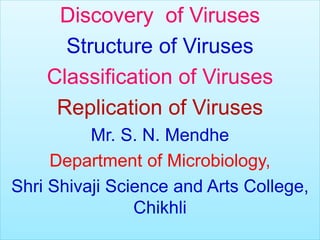
Unit i discovery of viruses ppt
- 1. Discovery of Viruses Structure of Viruses Classification of Viruses Replication of Viruses Mr. S. N. Mendhe Department of Microbiology, Shri Shivaji Science and Arts College, Chikhli
- 2. UNIT NO.I : VIRUSES Discovery of viruses Structure of viruses Classification of viruses (LHT System) Replication of viruses- Lytic cycle (T4), Lysogeny (Lambda phage) Cultivation of viruses- Embryo culture, Tissue culture method. Interferon
- 3. Discovery of Viruses:- In 1892, the Russian biologist Dimitry Ivanovsky (1864–1920) used a Chamberland filter to study the tobacco mosaic virus. He demonstrated that crushed leaf extracts from diseased tobacco plants remain infectious even after filtration. At that time, it was observed that all such infectious agents present in plant sap could be retained by bacteriological filters.
- 4. Such agent could not be grown on a nutrient medium. Nothing could be seen in such fluid with microscope.
- 5. In 1898, Martinus Beijerinck (1851– 1931) Dutch microbiologist repeated the experiments and became convinced that filtrate contained a new form of infectious agent. Beijerinck found that the filterable, non cultivable and invisible or ultramicroscopic agent could diffuse through an agar gel like a fluid.
- 6. He thought the fluid itself alive and called it a contagium vivum fluidum (soluble living germ) like a poisonous snake venom and re- introduced the word virus for such agent.
- 7. Beijerinck maintained that viruses were liquid in nature, a theory later discredited by Wendell Stanley, who crystallized the TMV and proved that they were particulate. In 1898, Loeffler and Frosch passed the first animal virus –agent of foot-and- mouth disease of cattle–through a similar filter and discovered first animal virus.
- 8. In 1915, the English bacteriologist Twort discovered a group of viruses that infect bacteria and French microbiologist d' Herelle described bacteriophages in detail. He named these viruses as a bacteriophages (phagein-to eat). Structure of Viruses:- Outside the host cell, the virus particle is also known as a virion or fully assembled infectious virus is called a virion.
- 9. The simplest virions consist of two basic components: nucleic acid (single-or double-stranded RNA or DNA) and a protein coat, the capsid, which functions as a shell to protect the viral genome from nucleases. In other words, viruses are ultramicroscopic particles containing nucleic acid surrounded by protein coat, to form nucleocapsid.
- 10. Certain viruses contain ribonucleic acid (RNA) while other viruses have deoxyribonucleic acid (DNA),genome which may be single-stranded or double- stranded; it may be linear or a closed loop. The genome of the virus is surrounded by a protein coat known as a capsid, made from a number of individual protein molecules called capsomeres. Capsomeres are arranged in a definite geometrical pattern around the nucleic acid.
- 11. Figure1.1:Schematic representation of Naked and Enveloped viruses The combination of genome and capsid is called the viral nucleocapsid. Such viruses are known as naked viruses, e.g. Polio virus, Adeno virus.
- 12. Figure1.1: Schematic representation of Naked and Enveloped viruses
- 13. The nucleocapsid may be surrounded by a membrane like envelope. Viruses that enclose the nucleocapsid by envelope are known as enveloped viruses. An envelope is a membrane like structure that is obtained from a host cell during the replication process. Enveloped viruses often exhibit a fringe of glycoprotein spikes or knobs, also called peplomers, e.g., Hepes simplex, Mumps, Influenza virus (Figure).
- 14. Simple structure Absence of cellular structure No independent metabolism Absence of cellular structure No independent metabolism Nucleic acids Crystallization No growth & division Size & visibility :- Viruses vary widely in size. The largest among them (e.g., poxviruses) measuring about 300. The smallest viruses (e.g.foot & mouth disease virus ) are about 20nm.
- 15. On the whole viruses are much smaller than bacteria. Mostly animal viruses, plant viruses & bacteriophages are invisible under the light microscope. As they are too small to be seen under the light microscope, they are also designated as ultramicroscopic. One of the larger viruses such as pox viruses, can be seen under the light microscope. Filterability:- Iwanowski demonstrated what was thought to be uniquely distinctive property of viruses, the ability when suspended in fluid to pass through the filters that would hold back bacteria.
- 16. Hence they are also known as filterable viruses. Simple structure:- Viruses have very simple structures. The simplest viruses are nucleoprotein particles consisting of genetic material (DNA or RNA) surrounded by protein capsid. In this respect they differ from typical cells which are made up proteins, carbohydrates, lipids & nucleic acids. Absenceofcellularstructure:- Viruses do not have any cytoplasm, thus cytoplasmic organelles like mitochonria, golgib complexs, ribosomes etc. are absent. They do not have limiting cell membrane.
- 18. No independent metabolism:- Viruses can not multiply outside a living cell. No virus has been cultivated in cell free medium. Viruses do not have independent metabolism. They are metabolically inactive outside the host cell, because they do not posses enzyme systems & protein synthesis machinery. Viral nucleic acid replicate by utilizing protein synthesis machinery of the host. It codes for the synthesis of a number of viral proteins including subunits or capsomeres of the capsomeres tail proteins & some enzymes concerned with the synthesis or release of virions.
- 19. Nucleic acids:- Virions have only one nucleic acid, either DNA or RNA. Typical cells have both DNA & RNA. Crystallization:- Many of the smaller viruses can be crystallized & thus behave like chemicals. No growth & division:- Viruses do not have power of growth & division. A fully formed virus does not increase in size by addition of new molecules.